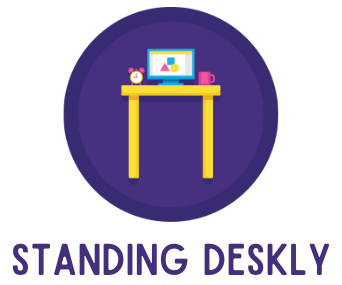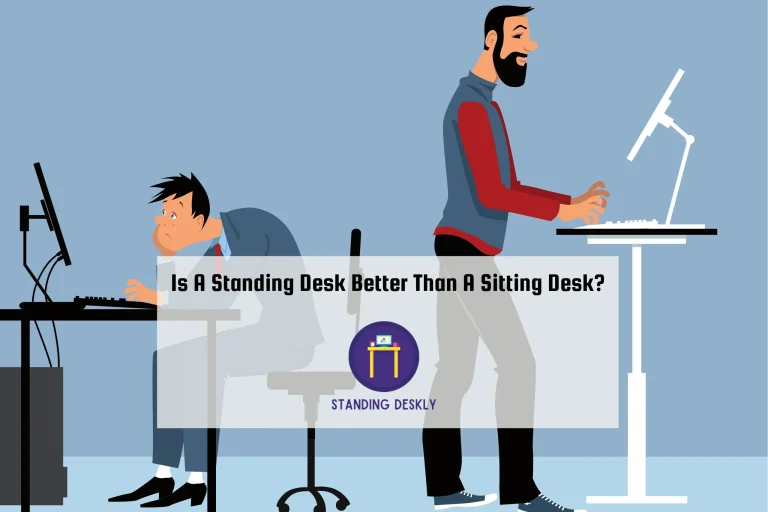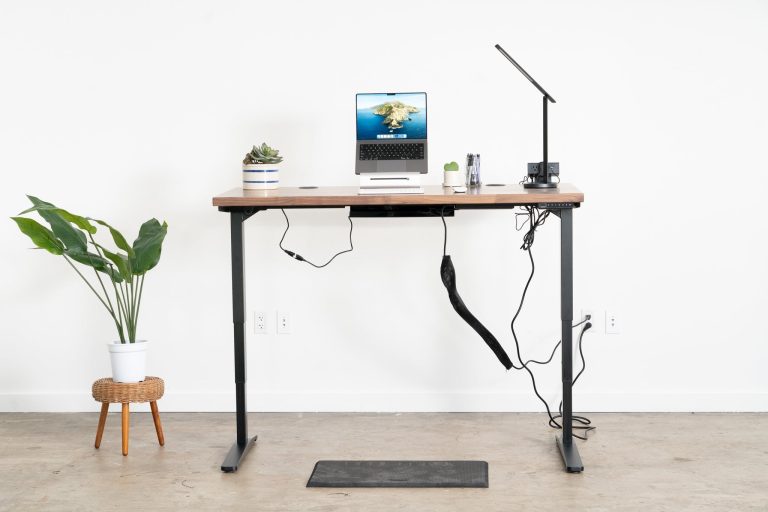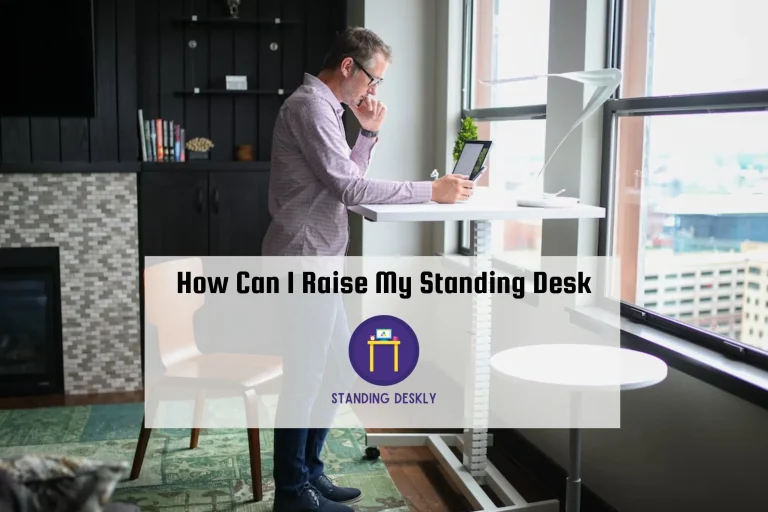How Often Should You Use Standing Desk?
According to Harvard Health Publishing, there’s no “one size fits all” answer. It’s recommended to mix up sitting and standing throughout the day to avoid prolonged periods of either. Switching positions every 30 minutes to an hour is a reasonable goal. It’s also important to listen to your body and adjust accordingly. If standing for too long causes discomfort, take a break and sit for a while. Remember to maintain good posture while using a standing desk, and consider anti-fatigue mats and proper footwear for added comfort. Overall, incorporating standing into your daily routine in moderation can offer potential health benefits.
The Proper Way To Use Standing Desk
If you’re thinking about using a standing desk, it’s important to use it correctly to avoid any negative effects on your health. To start, it’s recommended that you alternate between sitting and standing to prevent lower back pain and other issues.
For every 1 to 2 hours you sit, stand for 1 hour. Adjust your desk and computer screen to the proper height to avoid any discomfort or injury. You can also use an anti-fatigue mat to reduce discomfort and fatigue. Lastly, be mindful of your keyboard and mouse position to prevent wrist strain.
Remember to set a reminder to alternate between sitting and standing, and gradually work up to the recommended standing time for your workday. With these tips, using a standing desk can be beneficial for your health and productivity.
Section 1: The Ideal Duration
When it comes to using a standing desk, it’s important to find the ideal duration that works for you. Focusing on standing for too long without movement can lead to health risks such as lower back pain and chronic venous insufficiency.
Experts recommend standing for 5–15 minutes out of every hour and taking breaks from sitting for at least 2 hours in an 8-hour workday. It’s crucial to find the right mix of standing and sitting to avoid discomfort and increase productivity.
Alternate between sitting and standing every 30 minutes or so to see the most benefits. Remember to prioritize standing when possible and to adjust your desk to your height. By following these tips, you can maximize the benefits of using a standing desk and prevent any potential health risks.
Section 3: Balancing Sitting and Standing
When it comes to using a standing desk, finding the right balance between sitting and standing is crucial for your health and productivity. Standing for a long time can hurt your lower back and cause other health problems. But sitting for a long time is also bad and makes you more likely to get cancer or heart disease.
Experts recommend a 1:1 to 1:3 ratio of sitting to standing, alternating between positions every 30 minutes or so. It is also essential to take regular breaks and stretch throughout the day to alleviate physical discomfort and eyestrain.
Remember to prioritize standing when possible and find the right mix of sitting and standing that works best for your body and routine. With an adjustable standing desk and proper habits, you can improve your overall well-being in the workplace.
Section 4: Listen to Your Body
Listen to Your Body when using a standing desk. Although standing for long periods has its benefits, it’s not for everyone. If you experience discomfort or fatigue, it’s a sign that it’s time to sit down and take a break.
Common symptoms include back pain, knee pain, and discomfort in your feet. Remember, it’s not about standing all the time, but finding the right balance between standing and sitting. Take short breaks frequently if you are standing for long periods.
Walking around, stretching, and massaging your feet can also help. Additionally, adjust your desk to the right ergonomic position, and wear comfortable shoes with good support. Your body is unique, so listen to its needs and adjust your standing routine accordingly.
Section 5: Tips for Making the Switch
When the switch to a standing desk, there are some important tips to keep in mind.
- First, remember to alternate between sitting and standing. This will help to prevent negative effects on your leg muscles and other connective tissue, as well as minimize lower back pain. Aim for a ratio of 1:1 or 2:1 sitting versus standing time, and try to alternate between the two every 30 to 60 minutes.
- Second, adjust your desk and screen to the correct height and position. Your desk should align with your elbows, while the top of your screen should be at eye level.
- Third, consider purchasing an anti-fatigue mat to combat standing fatigue and improve overall discomfort.
- Finally, be mindful of the position of your keyboard and mouse to optimize wrist position and prevent strain.
With these tips in mind, you can make the switch to a standing desk in a safe and effective manner.
Using anti-fatigue mats to reduce discomfort
If for extended periods is part of your work routine or daily life, you may experience foot and leg discomfort.
Luckily, anti-fatigue mats are an easy and effective solution. These mats are designed to reduce the pressure on your body as you stand, which lowers the risk of varicose veins, heart disease, and joint pain.
Anti-fatigue mats also promote better blood circulation and reduce overall fatigue. They can also be helpful in preventing slips and falls in the office. When choosing an anti-fatigue mat, be sure to select a high-quality one that won’t lose its shape easily.
In addition to standing desks, anti-fatigue mats can be used in other areas, such as the kitchen, garage, and laundry room. Investing in anti-fatigue mats is a small step you can take for a more comfortable and healthy lifestyle.
Positioning keyboard and mouse correctly
To your keyboard and mouse correctly while using a standing desk, you should ensure that your elbows are at a 90-degree angle and close to your body. This means that your keyboard should be at a height that allows your hands to be at your elbow’s height or slightly lower.
Moreover, your wrists should be bent at a comfortable angle of around 10 degrees to ensure no strain. Your mouse should be close to the keyboard, and it’s essential to ensure that the mouse and keyboard are on the same level.
To prevent neck and shoulder pain, you should keep your shoulders back and your head balanced over your spine. Keeping these factors in mind will help reduce the risks of musculoskeletal disorders, increase comfort levels and maintain good posture.
Creating a standing routine and incorporating movement breaks
If’re using a standing desk, it’s important to have a consistent standing routine to maximize its benefits. Research suggests that a 1:1 to 1:3 ratio of sitting to standing is ideal for maintaining a healthy balance.
This means standing up for at least 30 minutes every hour, and sitting for no more than 15 minutes. Take breaks throughout the day to alternate between sitting and standing, and consider incorporating movement breaks to alleviate any physical discomfort.
Stretching every 15-minute break would also be beneficial to increase muscle blood flow, reduce tension, and improve productivity. Remember, the standing desk is only helpful if used properly.
Standing for too long can also lead to physical discomfort and fatigue, so find your optimal balance and prioritize your health and well-being throughout the workday.
Conclusion: Finding a Routine That Works
When comes to using a standing desk, it’s all about finding the right routine for you. Studies suggest that standing for at least 5-15 minutes every hour is beneficial for overall health and productivity.
However, it’s important to also prioritize breaks and stretching throughout the day to alleviate physical discomfort and eyestrain. An adjustable standing desk allows for the flexibility to alternate between sitting and standing every 30 minutes or so.
Remember, everyone’s body is different, so finding the right mix of sitting, standing, and stretching may take some trial and error. But through good work habits and setting realistic goals, you can find an optimal balance that promotes a happy, healthy, and productive workday.
References
https://edition.cnn.com/2019/09/12/health/standing-desks-tips-myths-facts-wellness/index.html
https://thestandingdesk.com/how-long-should-you-stand-at-a-standing-desk/
https://www.healthline.com/nutrition/6-tips-for-using-a-standing-desk
https://www.progressivedesk.com/blogs/top-tips/benefits-of-using-an-anti-fatigue-mat
https://www.startstanding.org/proper-workplace-ergonomics/
https://www.autonomous.ai/ourblog/9-true-health-benefits-of-a-standing-desk
https://www.health.harvard.edu/blog/the-truth-behind-standing-desks-2016092310264
https://ergonofis.com/en-us/blogs/news/how-to-use-my-sitstand-desk-correctly

I’m the author and developer of Standingdeskly, the go-to site for standing desk enthusiasts. I provide comprehensive reviews of standing desks along with office setup tips. Combining years of research and personal experience, our goal is to make it easy for you to find the perfect standing desk tailored to your needs.







